A Comprehensive Evaluation of Land Reclamation Effectiveness in Mining Areas: An Integrated Assessment of Soil, Vegetation, and Ecological Conditions
Abstract
1. Introduction
2. Materials
2.1. Study Area
2.2. Data
2.2.1. Measured Data
2.2.2. Landsat 8
3. Environmental Quality Assessment Model
3.1. Construction of the SQI
3.1.1. Membership Calculation
3.1.2. Minimum Selection of the Data Set
3.1.3. Weight Allocation and Soil Quality Indexes
3.2. Construction of the DRDI
3.3. Construction of the ECDI
3.4. Construction of CEQI
3.5. Statistical Analysis
4. Results
4.1. SQI Characteristics of Reclaimed Areas
4.1.1. Patterns of Spatial Variation in Soil Properties
4.1.2. Factorial Analysis
4.1.3. Statistical Features of SQI
4.2. DRDI Characteristics of Reclaimed Areas
4.3. ECDI Characteristics of Reclaimed Areas
4.4. CEQI Characteristics of Reclaimed Areas
5. Discussion
6. Conclusions
Author Contributions
Funding
Data Availability Statement
Acknowledgments
Conflicts of Interest
Abbreviations
| SQI | Soil Quality Index |
| CK | Control Area |
| MDS | Minimum Data Set |
| TDS | Total Data Set |
| DRDI | Dump Reclamation Disturbance Index |
| ECDI | Enhanced Coal Dust Index |
| CEQI | Comprehensive Evaluation Quality Index |
| PCA | Principal Component Analysis |
| EVI | Enhanced Vegetation Index |
| LST | Land Surface Temperature |
| NIR | Near-Infrared |
| SWIR1 | Short-Wave Infrared 1 |
| SWIR2 | Short-Wave Infrared 2 |
| IDW | Inverse Distance Weight |
References
- Gao, Z. Sustainable Development and Upgrading Mode of Coal Industry in China. Int. J. Min. Sci. Technol. 2012, 22, 335–340. [Google Scholar] [CrossRef]
- Li, Z.; Zhang, J.; Chen, H.; Shi, X.; Zhang, Y.; Zhang, Y. A Safe and Efficient Mining Method with Reasonable Stress Release and Surface Ecological Protection. Sustainability 2022, 14, 5348. [Google Scholar] [CrossRef]
- Wang, G.; Deng, J.; Zhang, Y.; Zhang, Q.; Duan, L.; Jiang, J.; Hao, J. Air Pollutant Emissions from Coal-Fired Power Plants in China over the Past Two Decades. Sci. Total Environ. 2020, 741, 140326. [Google Scholar] [CrossRef]
- Wang, W.; Zhang, C. Evaluation of Relative Technological Innovation Capability: Model and Case Study for China’s Coal Mine. Resour. Policy 2018, 58, 144–149. [Google Scholar] [CrossRef]
- Cao, W.; Bluth, C. Challenges and Countermeasures of China’s Energy Security. Energy Policy 2013, 53, 381–388. [Google Scholar] [CrossRef]
- Alemayehu, E.; Chala, E.T.; Jilo, N.Z.; Tiyasha, T.; Moges, B. Optimizing Design and Stability of Open Pit Slopes in Tolay Coal Mine, Ethiopia. Sci. Rep. 2025, 15, 1570. [Google Scholar] [CrossRef]
- Wang, Z.; Zhou, W.; Jiskani, I.M.; Yan, J.; Luo, H. Optimizing Open-Pit Coal Mining Operations: Leveraging Meteorological Conditions for Dust Removal and Diffusion. Int. J. Coal Sci. Technol. 2024, 11, 54. [Google Scholar] [CrossRef]
- Chen, Z.; Yang, Y.; Zhou, L.; Hou, H.; Zhang, Y.; Liang, J.; Zhang, S. Ecological Restoration in Mining Areas in the Context of the Belt and Road Initiative: Capability and Challenges. Environ. Impact Assess. Rev. 2022, 95, 106767. [Google Scholar] [CrossRef]
- Yang, W.; Mu, Y.; Zhang, W.; Wang, W.; Liu, J.; Peng, J.; Liu, X.; He, T. Assessment of Ecological Cumulative Effect Due to Mining Disturbance Using Google Earth Engine. Remote Sens. 2022, 14, 4381. [Google Scholar] [CrossRef]
- Shi, Z.; Bai, Z.; Guo, D.; Li, S.; Chen, M. Species Diversity and Soil Interconstraints Exert Significant Influences on Plant Survival during Ecological Restoration in Semi-Arid Mining Areas. Diversity 2023, 15, 1100. [Google Scholar] [CrossRef]
- Xu, Y.; Guo, L.; Li, J.; Zhang, C.; Ran, W.; Hu, J.; Mao, H. Automatically Identifying the Vegetation Destruction and Restoration of Various Open-Pit Mines Utilizing Remotely Sensed Images: Auto-VDR. J. Clean. Prod. 2023, 414, 137490. [Google Scholar] [CrossRef]
- Menta, C.; Conti, F.D.; Pinto, S.; Leoni, A.; Lozano-Fondon, C. Monitoring Soil Restoration in an Open-Pit Mine in Northern Italy. Appl. Soil. Ecol. 2014, 83, 22–29. [Google Scholar] [CrossRef]
- Han, Y.; Kou, J.; Jiang, B.; Li, J.; Liu, C.; Lei, S.; Xiao, H.; Feng, C. Bryophytes Adapt to Open-Pit Coal Mine Environments by Changing Their Functional Traits in Response to Heavy Metal-Induced Soil Environmental Changes. J. Hazard. Mater. 2025, 482, 136613. [Google Scholar] [CrossRef] [PubMed]
- Zhang, L.; Zhai, Z.; Zhou, Y.; Liu, S.; Wang, L. The Landscape Pattern Evolution of Typical Open-Pit Coal Mines Based on Land Use in Inner Mongolia of China during 20 Years. Sustainability 2022, 14, 9590. [Google Scholar] [CrossRef]
- Liu, X.; Zhou, W.; Bai, Z. Vegetation Coverage Change and Stability in Large Open-Pit Coal Mine Dumps in China during 1990–2015. Ecol. Eng. 2016, 95, 447–451. [Google Scholar] [CrossRef]
- Wang, Y.; Qin, K.; Zhang, Z.; He, Q.; Cohen, J. Mapping Open-Pit Mining Area in Complex Mining and Mixed Land Cover Zone Using Landsat Imagery. Int. J. Appl. Earth Obs. Geoinf. 2024, 129, 103782. [Google Scholar] [CrossRef]
- Li, Y.; Zhao, H.; Liu, J.; Chaonan, C.; Yuxuan, G. A Framework for Selecting and Assessing Soil Quality Indicators for Sustainable Soil Management in Waste Dumps. Sci. Rep. 2024, 14, 8491. [Google Scholar] [CrossRef]
- Dutta, M.; Saikia, J.; Taffarel, S.R.; Waanders, F.B.; de Medeiros, D.; Cutruneo, C.M.N.L.; Silva, L.F.O.; Saikia, B.K. Environmental Assessment and Nano-Mineralogical Characterization of Coal, Overburden and Sediment from Indian Coal Mining Acid Drainage. Geosci. Front. 2017, 8, 1285–1297. [Google Scholar] [CrossRef]
- Zhu, J.; Yang, Z.; Qin, F.; Guo, J.; Zhang, T.; Miao, P. Soil Quality Assessment of Several Kinds of Typical Artificial Forestlands in the Inner Mongolia Basin of the Yellow River. Land 2023, 12, 1024. [Google Scholar] [CrossRef]
- Xie, J.; Liu, Y.; Xie, M.; Xia, L.; Yang, R.; Li, J. Exploring the Restoration Stability of Abandoned Open-Pit Mines by Vegetation Resilience Indicator Based on the LandTrendr Algorithm. Ecol. Indic. 2024, 166, 112392. [Google Scholar] [CrossRef]
- He, J.; Yan, Z.; Du, Y.; Wang, Z.; Hu, Y.; Wu, L.; Luo, R.; Wang, J.; Zhang, D.; Cao, Y. Identifying Key Indicators for Soil Quality Assessment in Reclaimed Loess Coal Mining Areas of China: A Case Study of the Suancigou Coal Mine, Inner Mongolia. Land Degradation & Development. 2025. [Google Scholar] [CrossRef]
- Yuanhe, X.; Xiaojie, Y.; Yongming, W. Techniques Ecological Restoration and Plant Restoration on Spoil Dump of Modern Strip Mine. Sci. Soil. Water Conserv. 2013, 11, 48–54. [Google Scholar] [CrossRef]
- Zhu, Q.; Nie, X.; Zhang, Y.; Hu, Z. Herbaceous Plant Species Selection for Ecological Restoration of Coal Gangue Hills in North China. J. Beijing For. Univ. 2021, 43, 90–97. [Google Scholar] [CrossRef]
- Zhou, G.; Qi, X. Analysis of Inter-Annual Variation in Land Reclamation Success in Open-pit Mining Dumps in Cold and Arid Regions. Open-Pit Min. Technol. 2023, 38, 28–31. [Google Scholar] [CrossRef]
- Wang, S.; Ma, C.; Ma, Y.; Li, T. Monitoring and Evaluation of Ecological Restoration in Open-Pit Coal Mine Using Remote Sensing Data Based on a OM-RSEI Model. Int. J. Min. Reclam. Environ. 2025, 1–23. [Google Scholar] [CrossRef]
- Hu, J.; Ye, B.; Bai, Z.; Feng, Y. Remote Sensing Monitoring of Vegetation Reclamation in the Antaibao Open-Pit Mine. Remote Sens. 2022, 14, 5634. [Google Scholar] [CrossRef]
- Zhong, A.; Wang, Z.; Zhang, Z.; Hu, C. Remote Sensing Monitoring of Ecological Environment Quality in Mining Areas under the Perspective of Ecological Engineering. Environ. Earth Sci. 2024, 83, 587. [Google Scholar] [CrossRef]
- Yu, H.; Zahidi, I.; Liang, D. Mine Land Reclamation, Mine Land Reuse, and Vegetation Cover Change: An Intriguing Case Study in Dartford, the United Kingdom. Environ. Res. 2023, 225, 115613. [Google Scholar] [CrossRef]
- Gordon, S.; Xu, X.; Wang, Y. Remote Sensing-Based Revegetation Assessment at Post-Closure Mine Sites in Canada. Sustainability 2023, 15, 11287. [Google Scholar] [CrossRef]
- Xu, H.; Xu, F.; Lin, T.; Xu, Q.; Yu, P.; Wang, C.; Aili, A.; Zhao, X.; Zhao, W.; Zhang, P.; et al. A Systematic Review and Comprehensive Analysis on Ecological Restoration of Mining Areas in the Arid Region of China: Challenge, Capability and Reconsideration. Ecol. Indic. 2023, 154, 110630. [Google Scholar] [CrossRef]
- Chen, X.; Li, W.; Chen, J.; Rao, Y.; Yamaguchi, Y. A Combination of TsHARP and Thin Plate Spline Interpolation for Spatial Sharpening of Thermal Imagery. Remote Sens. 2014, 6, 2845–2863. [Google Scholar] [CrossRef]
- Sattari, F.; Hashim, M.; Sookhak, M.; Banihashemi, S.; Pour, A.B. Assessment of the TsHARP Method for Spatial Downscaling of Land Surface Temperature over Urban Regions. Urban. Clim. 2022, 45, 101265. [Google Scholar] [CrossRef]
- Li, H.; Chen, W.; Fu, K.; Zhang, C.; Liang, H. Changes in Soil Quality during Different Ecological Restoration Years in the Abandoned Coal Mine Area of Southern China. Soil. Sci. Soc. Am. J. 2024, 88, 2311–2328. [Google Scholar] [CrossRef]
- Guo, S.; Xu, Y.; He, C.; Wu, S.; Ren, C.; Han, X.; Feng, Y.; Ren, G.; Yang, G. Differential Responses of Soil Quality in Revegetation Types to Precipitation Gradients on the Loess Plateau. Agric. For. Meteorol. 2019, 276, 107622. [Google Scholar] [CrossRef]
- Peng, J.; Long, L.; Guo, Z.; Wang, J.; Cai, C. Construction of Soil Quality Index and Its Spatial Distribution in Eroded Farmlands of Northeast Black Soil Region. J. Agric. Eng. 2024, 40, 54–64. [Google Scholar]
- Li, X.; Wang, D.; Ren, Y.; Wang, Z.; Zhou, Y. Soil Quality Assessment of Croplands in the Black Soil Zone of Jilin Province, China: Establishing a Minimum Data Set Model. Ecol. Indic. 2019, 107, 105251. [Google Scholar] [CrossRef]
- Andrews, S.S.; Karlen, D.L.; Mitchell, J.P. A Comparison of Soil Quality Indexing Methods for Vegetable Production Systems in Northern California. Agric. Ecosyst. Environ. 2002, 90, 25–45. [Google Scholar] [CrossRef]
- Miaomiao, X.; Shuting, G.; Shaoling, L.; Yan, Z.; Zhongke, B.; Yu, Z. Construction and Spatiotemporal Variation of Dump Reclamation Disturbance Index. Trans. Chin. Soc. Agric. Eng. 2019, 35, 258–265. [Google Scholar] [CrossRef]
- Yang, J.; Zhang, D. Soil Moisture Estimation with a Remotely Sensed Dry Edge Determination Based on the Land Surface Temperature-Vegetation Index Method. JARS 2019, 13, 024511. [Google Scholar] [CrossRef]
- Peng, Q.; Wang, R.; Jiang, Y.; Wu, X. Adaptability of Drought Situation Monitoring in Xinjiang with the NDVI-LST Index. Acta Ecol. Sin. 2018, 38, 4694–4703. [Google Scholar] [CrossRef][Green Version]
- Xia, N.; Hai, W.; Song, G.; Tang, M. Identification and Monitoring of Coal Dust Pollution in Wucaiwan Mining Area, Xinjiang (China) Using Landsat Derived Enhanced Coal Dust Index. PLoS ONE 2022, 17, e0266517. [Google Scholar] [CrossRef]
- Krishnan, A.R.; Kasim, M.M.; Hamid, R.; Ghazali, M.F. A Modified CRITIC Method to Estimate the Objective Weights of Decision Criteria. Symmetry 2021, 13, 973. [Google Scholar] [CrossRef]
- Huang, Y.; Kuang, X.; Cao, Y.; Bai, Z. The Soil Chemical Properties of Reclaimed Land in an Arid Grassland Dump in an Opencast Mining Area in China. RSC Adv. 2018, 8, 41499–41508. [Google Scholar] [CrossRef]
- Cao, Y.; Ai, Z.; Dang, X.; Hou, M.; Liu, H.; Li, Q.; Yao, Y.; Deng, Y.; Zhu, S.; Xiao, L. Effects of Different Reclamation Measures on Soil Quality Restoration in Open-Pit Mines: A Meta-Analysis Based on the Chinese Loess Plateau. Ecol. Eng. 2024, 203, 107257. [Google Scholar] [CrossRef]
- Qiu, H.; Zhang, J.; Han, H.; Cheng, X.; Kang, F. Study on the Impact of Vegetation Change on Ecosystem Services in the Loess Plateau, China. Ecol. Indic. 2023, 154, 110812. [Google Scholar] [CrossRef]
- Long, Z.; Zhu, H.; Wu, Y.; Ma, Z.; Yu, D.; Bing, H. Aboveground Plant Biomass Drove the Reclamation-Year Dependence of Soil Quality along a 49-Year Vegetation Reclamation Chronosequence. Plant Soil 2024, 1–15. [Google Scholar] [CrossRef]
- Kayet, N.; Pathak, K.; Singh, C.P.; Chaturvedi, R.K.; Brahmandam, A.S.V.; Mandal, C. Assessment and Estimation of Coal Dust Impact on Vegetation Using VIs Difference Model and PRISMA Hyperspectral Data in Mining Sites. J. Environ. Manag. 2024, 367, 121935. [Google Scholar] [CrossRef]
- Salazar, M.; Bosch-Serra, A.; Estudillos, G.; Poch, R.M. Rehabilitation of Semi-Arid Coal Mine Spoil Bank Soils with Mine Residues and Farm Organic By-Products. Arid Land Res. Manag. 2009, 23, 327–341. [Google Scholar] [CrossRef]
- Gómez-Plaza, A.; Martínez-Mena, M.; Albaladejo, J.; Castillo, V.M. Factors Regulating Spatial Distribution of Soil Water Content in Small Semiarid Catchments. J. Hydrol. 2001, 253, 211–226. [Google Scholar] [CrossRef]
- Cho, E.; Choi, M. Regional Scale Spatio-Temporal Variability of Soil Moisture and Its Relationship with Meteorological Factors over the Korean Peninsula. J. Hydrol. 2014, 516, 317–329. [Google Scholar] [CrossRef]
- Zhou, J.; Sun, W.; Meng, X.; Yang, G.; Ren, K.; Peng, J. Generalized Linear Spectral Mixing Model for Spatial–Temporal–Spectral Fusion. IEEE Trans. Geosci. Remote Sens. 2022, 60, 1–16. [Google Scholar] [CrossRef]
- Lei, D.; Zhu, Q.; Li, Y.; Tan, J.; Wang, S.; Zhou, T.; Zhang, L. HPLTS-GAN: A High-Precision Remote Sensing Spatiotemporal Fusion Method Based on Low Temporal Sensitivity. IEEE Trans. Geosci. Remote Sens. 2024, 62, 5407416. [Google Scholar] [CrossRef]

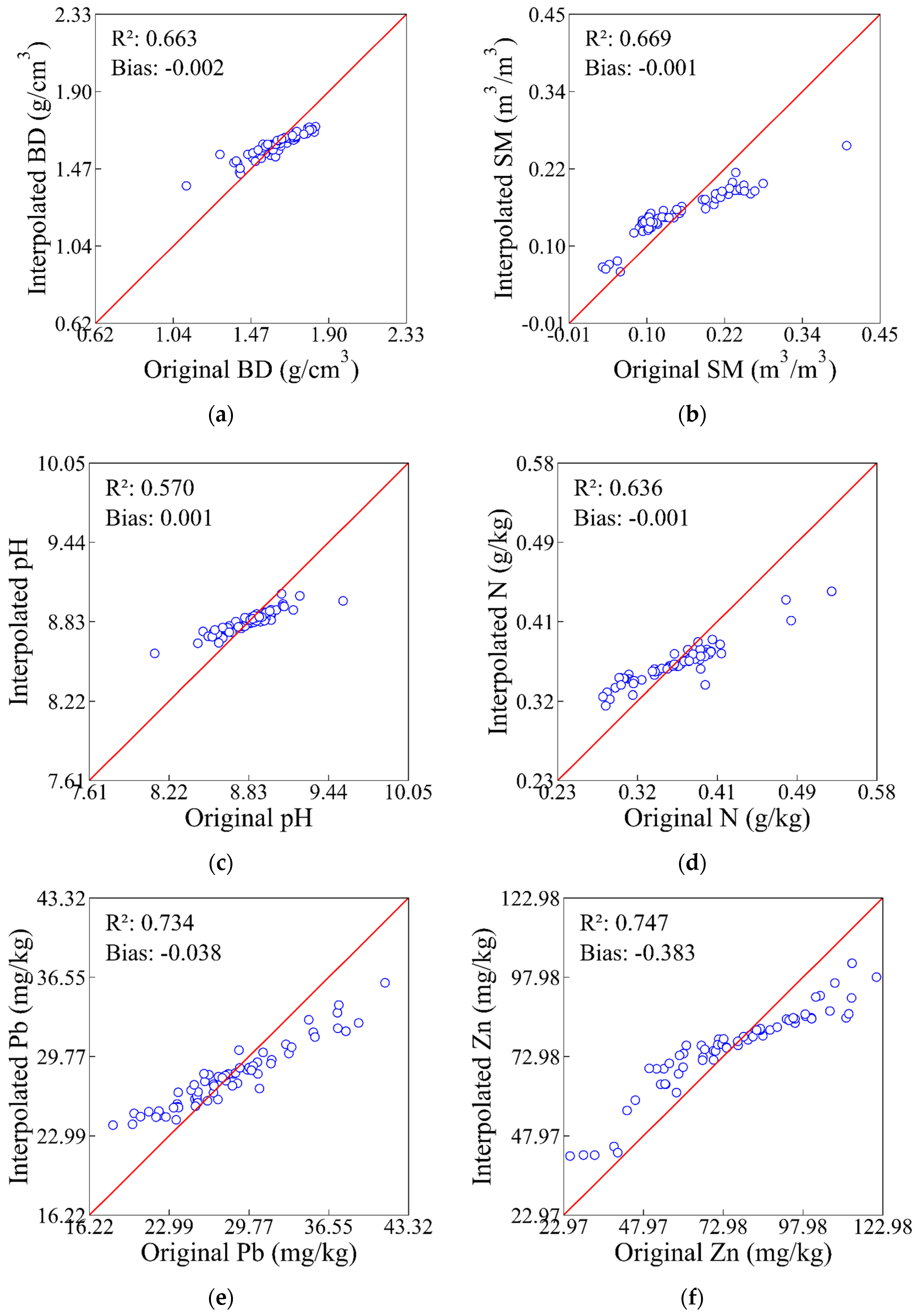
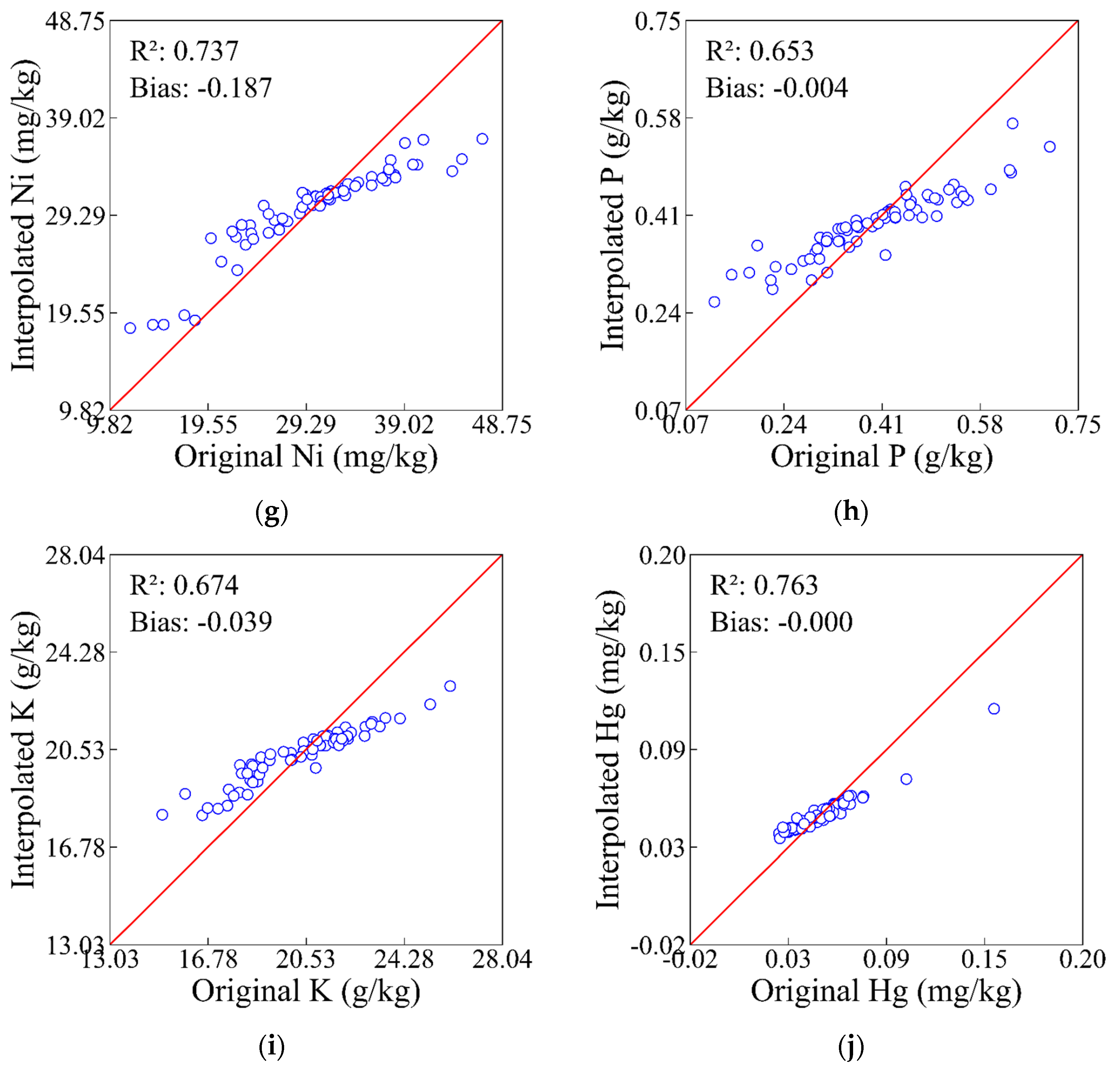
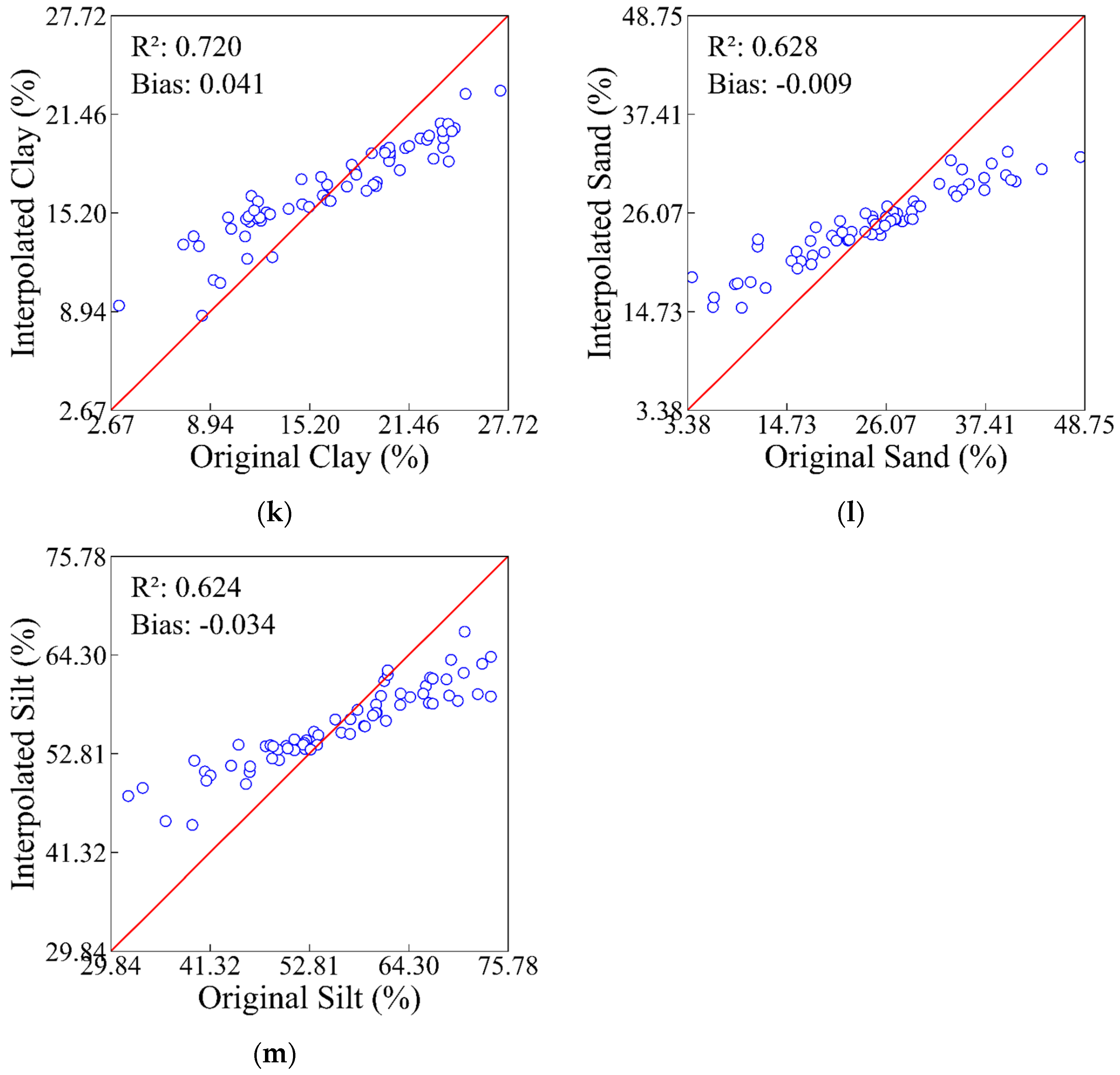
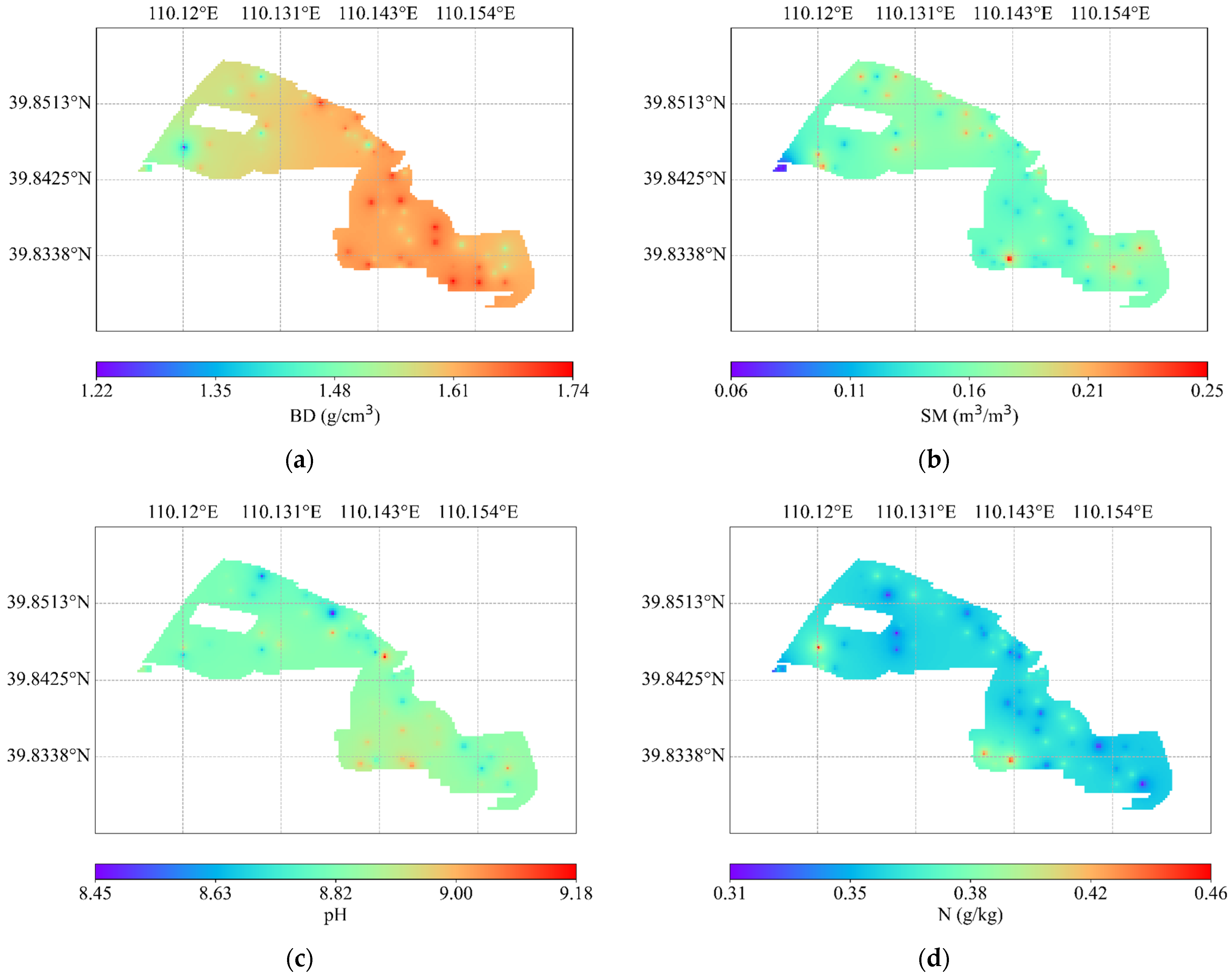
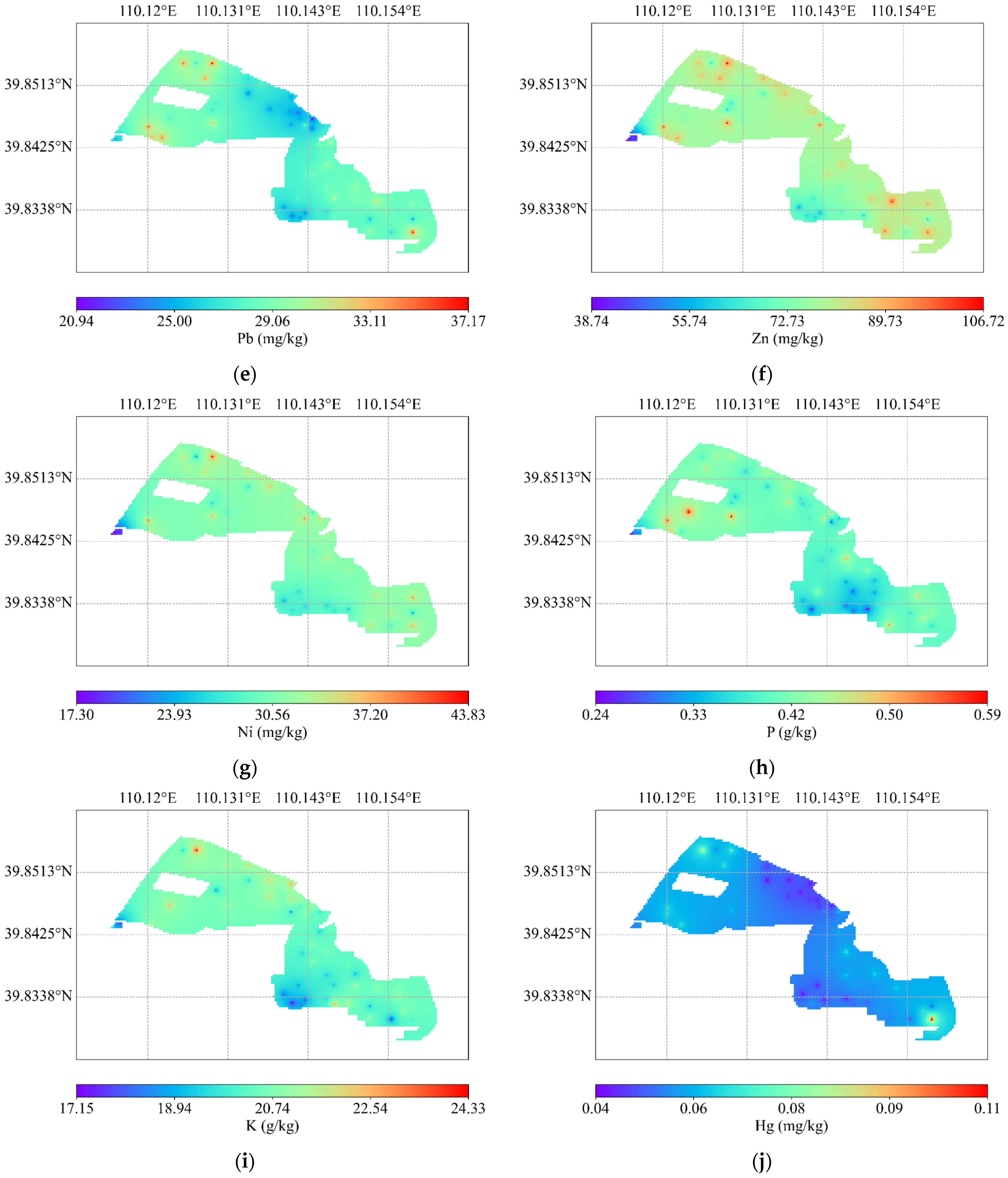
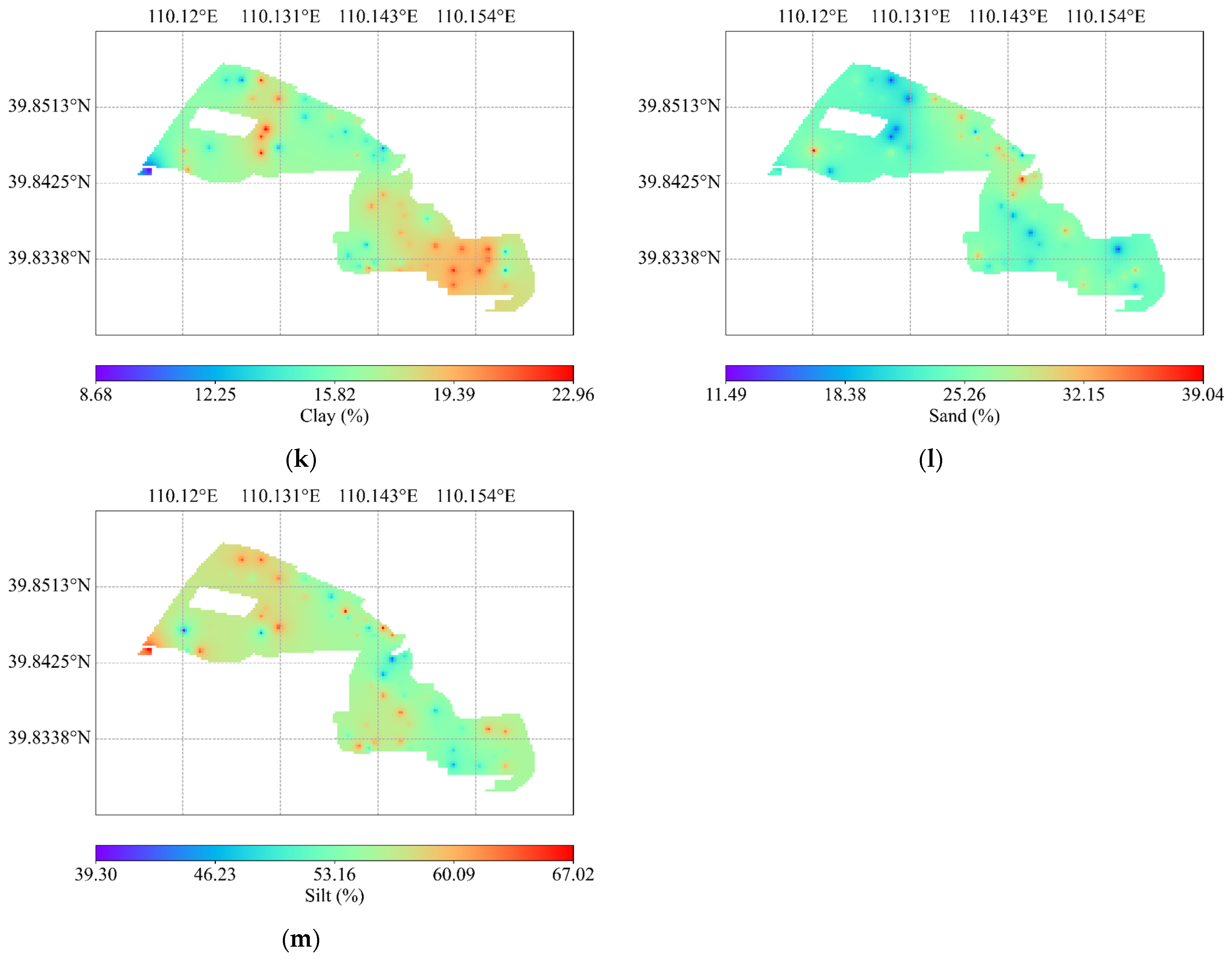
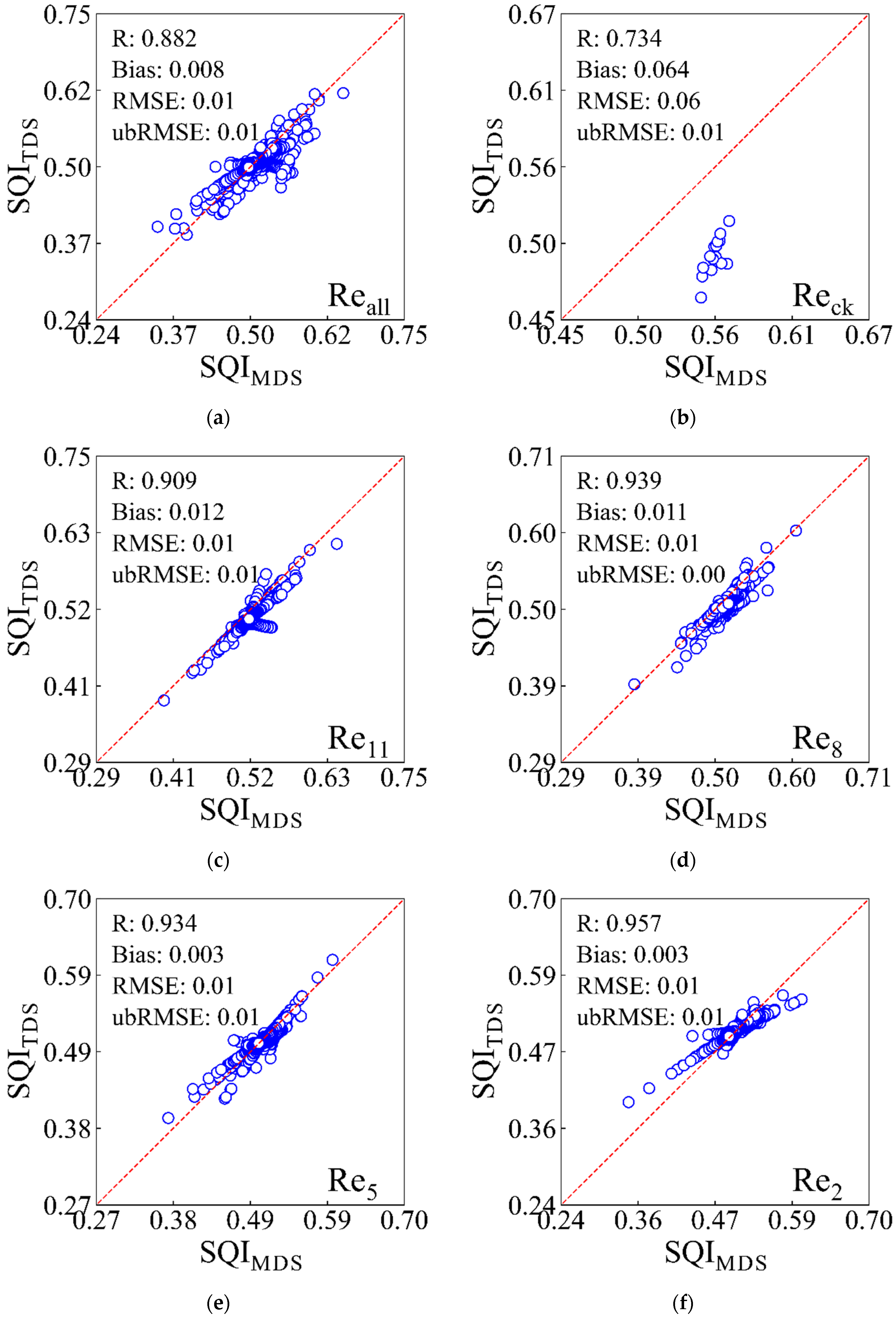
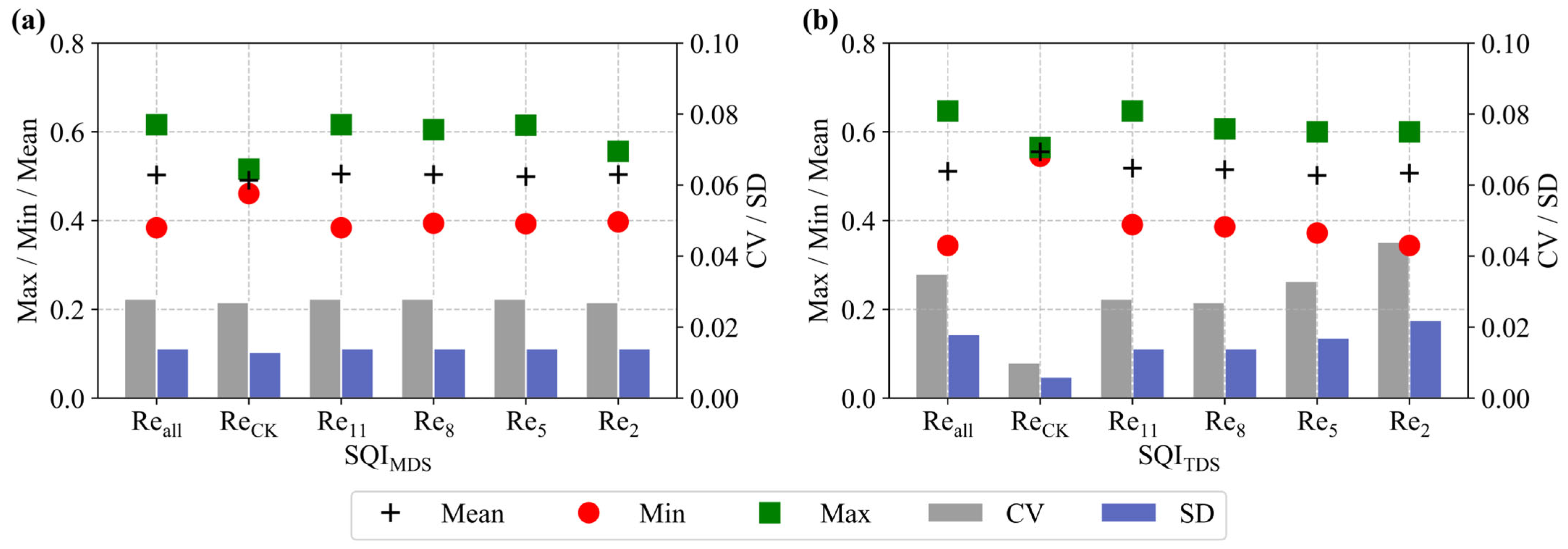
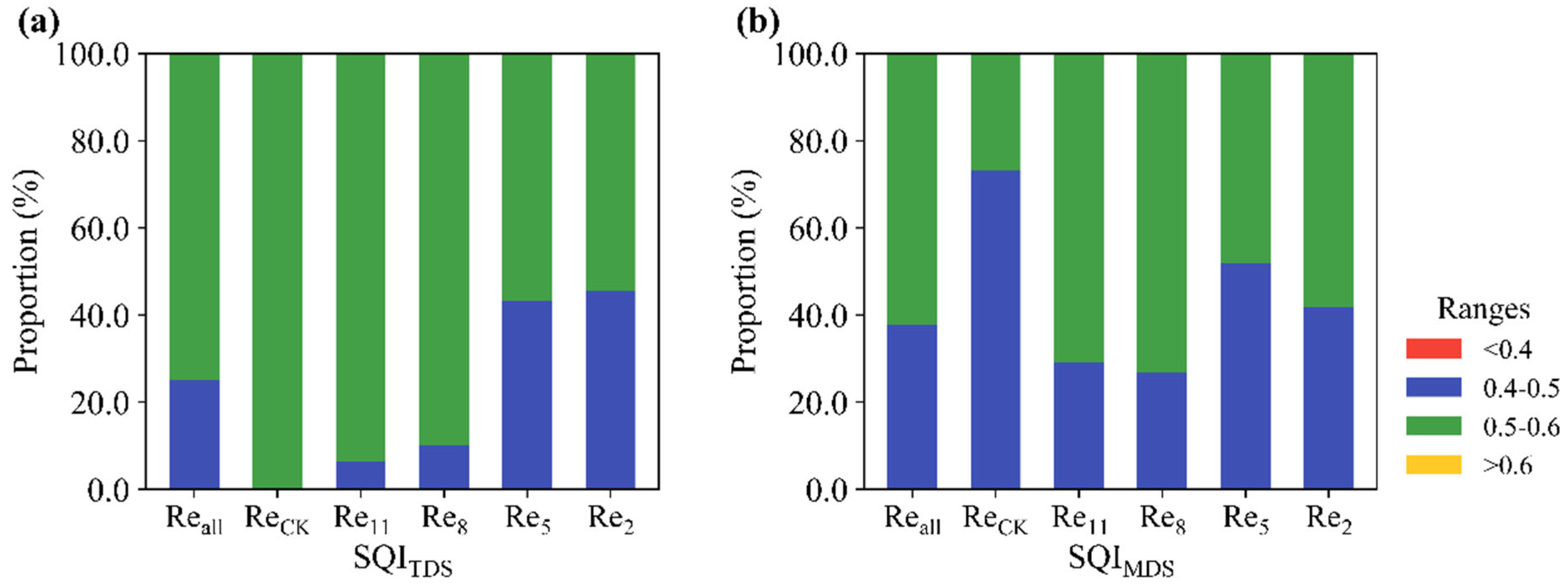
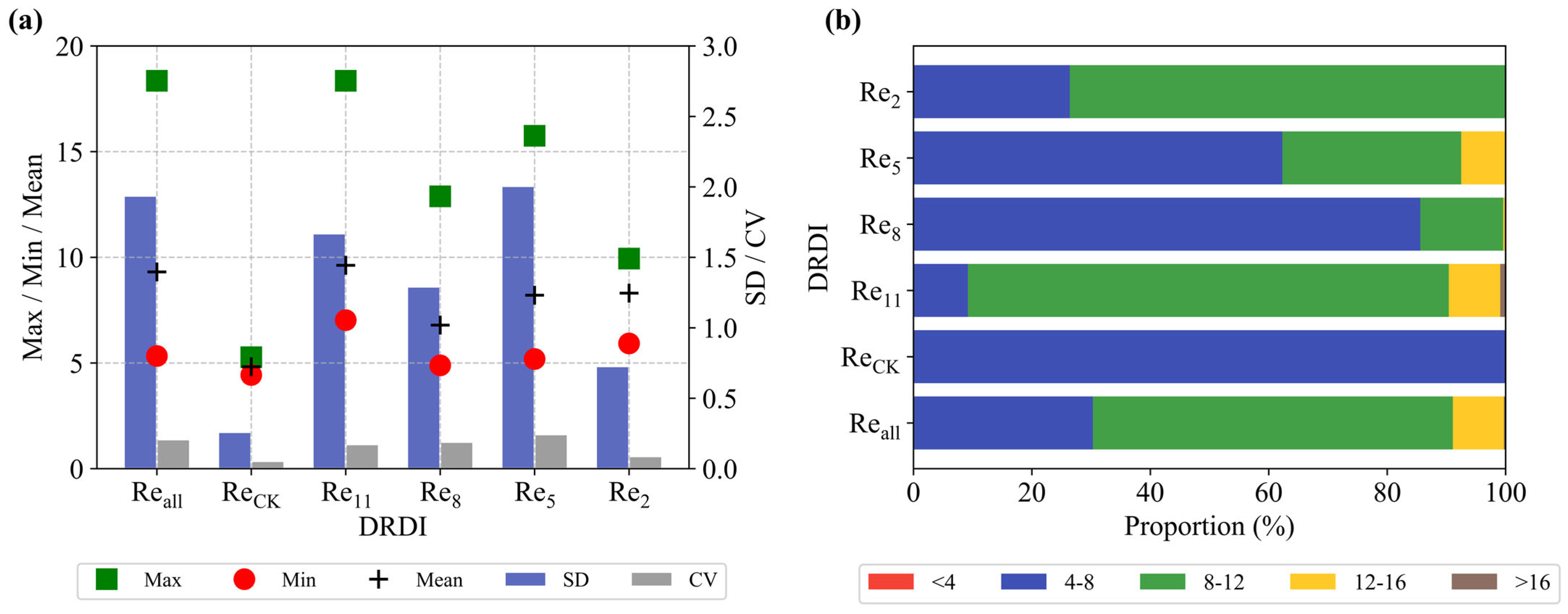

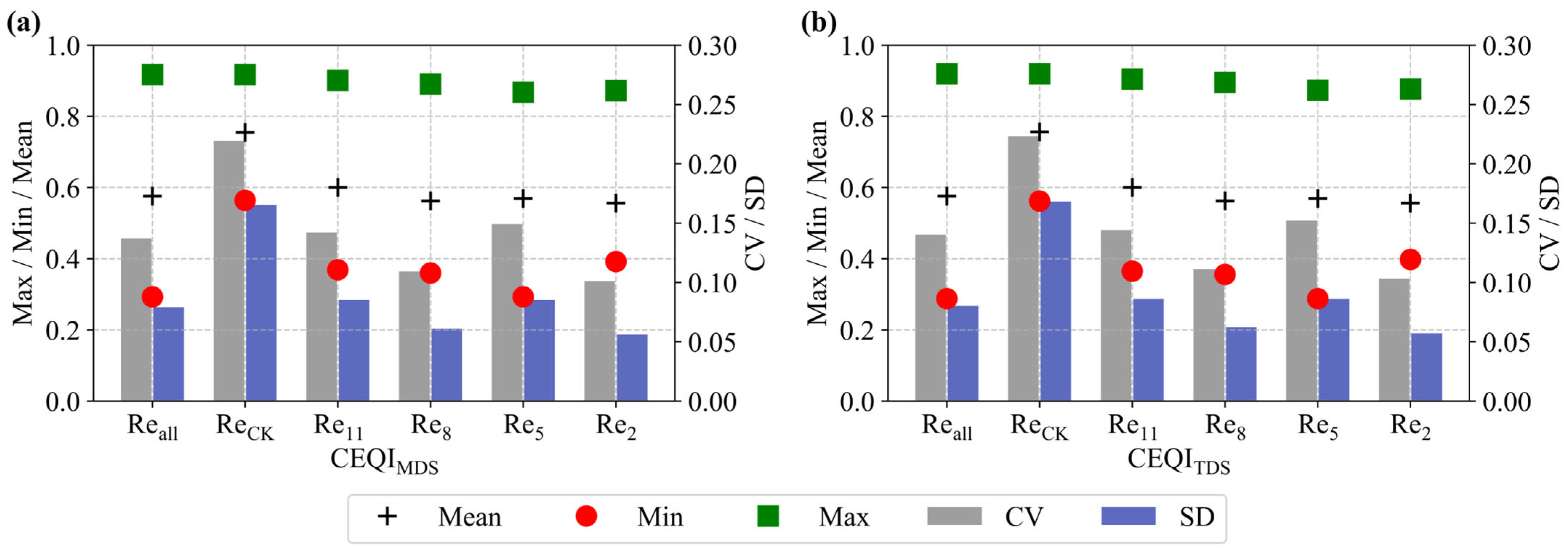
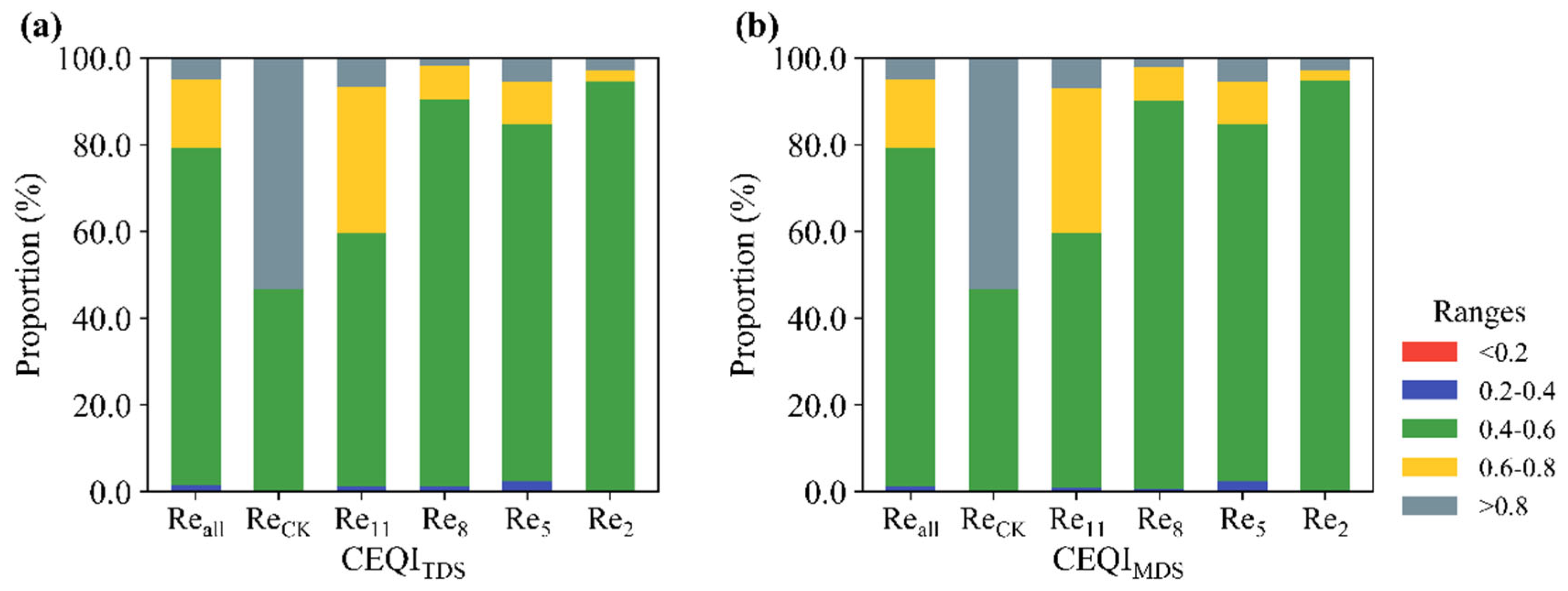
| Reclaimed Area | Reclamation Period | Vegetation Configurations | Plot Size (km2) |
|---|---|---|---|
| Re2 | 2021~2022 | Shrubs and Grass | 0.732 |
| Re5 | 2018~2021 | Shrubs and Grass | 1.153 |
| Re8 | 2015~2018 | Shrubs and Grass | 0.786 |
| Re11 | 2012~2015 | Tree, Shrubs, and Grass | 1.282 |
| CK | - | Grass | - |
| Function | Properties |
|---|---|
| Positive indicators | SM (m3/m3), pH, N(g/kg), P (mg/kg), K(mg/kg), Clay (%), and Sand (%) |
| Negative indicators | BD (g/cm3), Silt (%), Pb (mg/kg), Zn (mg/kg), Ni (mg/kg), and Hg (mg/kg) |
| Properties | Re2 | Re5 | Re8 | Re11 | CK | Reall | |
|---|---|---|---|---|---|---|---|
| BD (g/cm3) | Mean | 1.658 | 1.627 | 1.621 | 1.469 | 1.480 | 1.597 |
| Median | 1.678 | 1.59 | 1.635 | 1.48 | 1.413 | 1.606 | |
| SD | 0.102 | 0.127 | 0.117 | 0.129 | 0.103 | 0.065 | |
| SM (m3/m3) | Mean | 0.156 | 0.151 | 0.166 | 0.206 | 0.050 | 0.154 |
| Median | 0.12 | 0.132 | 0.149 | 0.21 | 0.047 | 0.153 | |
| SD | 0.081 | 0.054 | 0.056 | 0.058 | 0.011 | 0.034 | |
| pH | Mean | 8.906 | 8.836 | 8.795 | 8.79 | 8.834 | 8.831 |
| Median | 8.895 | 8.885 | 8.78 | 8.800 | 8.800 | 8.838 | |
| SD | 0.18 | 0.161 | 0.311 | 0.163 | 0.097 | 0.082 | |
| N (g/kg) | Mean | 0.376 | 0.351 | 0.356 | 0.348 | 0.334 | 0.358 |
| Median | 0.369 | 0.357 | 0.368 | 0.352 | 0.308 | 0.357 | |
| SD | 0.061 | 0.038 | 0.036 | 0.039 | 0.052 | 0.021 | |
| Pb (mg/kg) | Mean | 26.813 | 30.019 | 23.95 | 33.58 | 25.340 | 27.946 |
| Median | 25.85 | 29.7 | 23.75 | 34.8 | 25.300 | 27.709 | |
| SD | 4.975 | 2.609 | 3.333 | 4.01 | 1.205 | 2.628 | |
| Zn (mg/kg) | Mean | 68.644 | 83.431 | 81.356 | 97.12 | 33.100 | 75.919 |
| Median | 59.85 | 82.9 | 81.05 | 97.5 | 32.700 | 78.248 | |
| SD | 20.396 | 13.424 | 16.949 | 19.014 | 6.296 | 12.843 | |
| Ni (mg/kg) | Mean | 27.838 | 32.063 | 32.775 | 33.06 | 15.300 | 30.154 |
| Median | 25.6 | 31.8 | 31.25 | 33.1 | 15.100 | 31.275 | |
| SD | 6.262 | 3.914 | 5.703 | 7.421 | 2.566 | 4.205 | |
| P (g/kg) | Mean | 0.36 | 0.396 | 0.411 | 0.359 | 0.276 | 0.393 |
| Median | 0.358 | 0.406 | 0.406 | 0.364 | 0.285 | 0.395 | |
| SD | 0.128 | 0.107 | 0.106 | 0.069 | 0.109 | 0.058 | |
| K (g/kg) | Mean | 19.388 | 20.373 | 21.181 | 21.342 | 18.251 | 20.360 |
| Median | 19.106 | 20.767 | 21.69 | 21.304 | 17.983 | 20.649 | |
| SD | 2.696 | 1.416 | 1.925 | 2.357 | 1.617 | 1.023 | |
| Hg (mg/kg) | Mean | 0.052 | 0.059 | 0.041 | 0.06 | 0.051 | 0.053 |
| Median | 0.045 | 0.056 | 0.038 | 0.06 | 0.050 | 0.052 | |
| SD | 0.028 | 0.007 | 0.01 | 0.01 | 0.004 | 0.010 | |
| Clay (%) | Mean | 17.892 | 19.388 | 14.488 | 12.97 | 8.626 | 16.887 |
| Median | 19.532 | 20.102 | 14.299 | 12.84 | 9.145 | 16.996 | |
| SD | 5.365 | 3.897 | 3.558 | 6.143 | 3.489 | 3.011 | |
| Sand (%) | Mean | 25.919 | 24.298 | 28.38 | 21.65 | 21.967 | 24.758 |
| Median | 26.826 | 24.132 | 28.262 | 21.71 | 21.711 | 25.141 | |
| SD | 6.697 | 12.307 | 9.435 | 4.669 | 3.355 | 4.201 | |
| Silt (%) | Mean | 53.978 | 53.884 | 55.023 | 62.89 | 65.937 | 55.982 |
| Median | 52.209 | 53.071 | 52.325 | 61.85 | 61.852 | 55.370 | |
| SD | 8.618 | 11.632 | 10.33 | 7.881 | 5.877 | 4.607 | |
| Properties | F1 | F2 | F3 | F4 | FC | Norm Value |
|---|---|---|---|---|---|---|
| BD (g/cm3) | −0.356 | 0.739 | 0.308 | −0.259 | - | 2.296 |
| SM (m3/m3) | −0.574 | −0.238 | 0.087 | 0.285 | - | 1.720 |
| pH | 0.715 | −0.148 | −0.440 | −0.036 | 1 | 2.714 |
| N (g/kg) | 0.469 | 0.050 | 0.262 | −0.397 | 2 | 1.307 |
| Pb (mg/kg) | 0.615 | −0.368 | 0.482 | 0.427 | 4 | 2.726 |
| Zn (mg/kg) | 0.854 | 0.442 | 0.101 | −0.042 | 1 | 3.768 |
| Ni (mg/kg) | 0.826 | 0.441 | −0.022 | −0.098 | - | 3.547 |
| P (g/kg) | −0.745 | 0.144 | 0.410 | −0.226 | 3 | 2.912 |
| K (g/kg) | −0.740 | 0.039 | 0.340 | 0.225 | 4 | 2.719 |
| Hg (mg/kg) | 0.512 | −0.345 | 0.572 | 0.424 | - | 2.360 |
| Clay (%) | −0.230 | −0.462 | −0.742 | 0.040 | 3 | 1.932 |
| Sand (%) | −0.155 | 0.644 | −0.524 | 0.470 | - | 2.042 |
| Silt (%) | 0.001 | 0.869 | −0.025 | 0.435 | 2 | 2.250 |
| Variance Percentage | 33.979 | 20.603 | 15.719 | 9.196 | - | - |
| Cumulative Variance Percentage | 33.979 | 54.582 | 70.301 | 79.497 | - | - |
| Properties | TDS | MDS | ||
|---|---|---|---|---|
| Commonality | Weight | Commonality | Weight | |
| BD (g/cm3) | 0.835 | 0.081 | - | - |
| SM (m3/m3) | 0.475 | 0.046 | - | - |
| pH | 0.727 | 0.070 | 0.738 | 0.124 |
| N (g/kg) | 0.448 | 0.043 | 0.478 | 0.080 |
| Pb (mg/kg) | 0.929 | 0.090 | 0.625 | 0.105 |
| Zn (mg/kg) | 0.936 | 0.091 | 0.855 | 0.144 |
| Ni (mg/kg) | 0.886 | 0.086 | - | - |
| P (g/kg) | 0.795 | 0.077 | 0.755 | 0.127 |
| K (g/kg) | 0.716 | 0.069 | 0.725 | 0.122 |
| Hg (mg/kg) | 0.888 | 0.086 | - | - |
| Clay (%) | 0.818 | 0.079 | 0.856 | 0.144 |
| Sand (%) | 0.935 | 0.090 | - | - |
| Silt (%) | 0.946 | 0.092 | 0.909 | 0.153 |
Disclaimer/Publisher’s Note: The statements, opinions and data contained in all publications are solely those of the individual author(s) and contributor(s) and not of MDPI and/or the editor(s). MDPI and/or the editor(s) disclaim responsibility for any injury to people or property resulting from any ideas, methods, instructions or products referred to in the content. |
© 2025 by the authors. Licensee MDPI, Basel, Switzerland. This article is an open access article distributed under the terms and conditions of the Creative Commons Attribution (CC BY) license (https://creativecommons.org/licenses/by/4.0/).
Share and Cite
Tang, Y.; Zhao, Y.; Li, Z.; He, M.; Sun, Y.; Hong, Z.; Ren, H. A Comprehensive Evaluation of Land Reclamation Effectiveness in Mining Areas: An Integrated Assessment of Soil, Vegetation, and Ecological Conditions. Remote Sens. 2025, 17, 1744. https://doi.org/10.3390/rs17101744
Tang Y, Zhao Y, Li Z, He M, Sun Y, Hong Z, Ren H. A Comprehensive Evaluation of Land Reclamation Effectiveness in Mining Areas: An Integrated Assessment of Soil, Vegetation, and Ecological Conditions. Remote Sensing. 2025; 17(10):1744. https://doi.org/10.3390/rs17101744
Chicago/Turabian StyleTang, Yanjie, Yanling Zhao, Zhibin Li, Meichen He, Yueming Sun, Zhen Hong, and He Ren. 2025. "A Comprehensive Evaluation of Land Reclamation Effectiveness in Mining Areas: An Integrated Assessment of Soil, Vegetation, and Ecological Conditions" Remote Sensing 17, no. 10: 1744. https://doi.org/10.3390/rs17101744
APA StyleTang, Y., Zhao, Y., Li, Z., He, M., Sun, Y., Hong, Z., & Ren, H. (2025). A Comprehensive Evaluation of Land Reclamation Effectiveness in Mining Areas: An Integrated Assessment of Soil, Vegetation, and Ecological Conditions. Remote Sensing, 17(10), 1744. https://doi.org/10.3390/rs17101744






